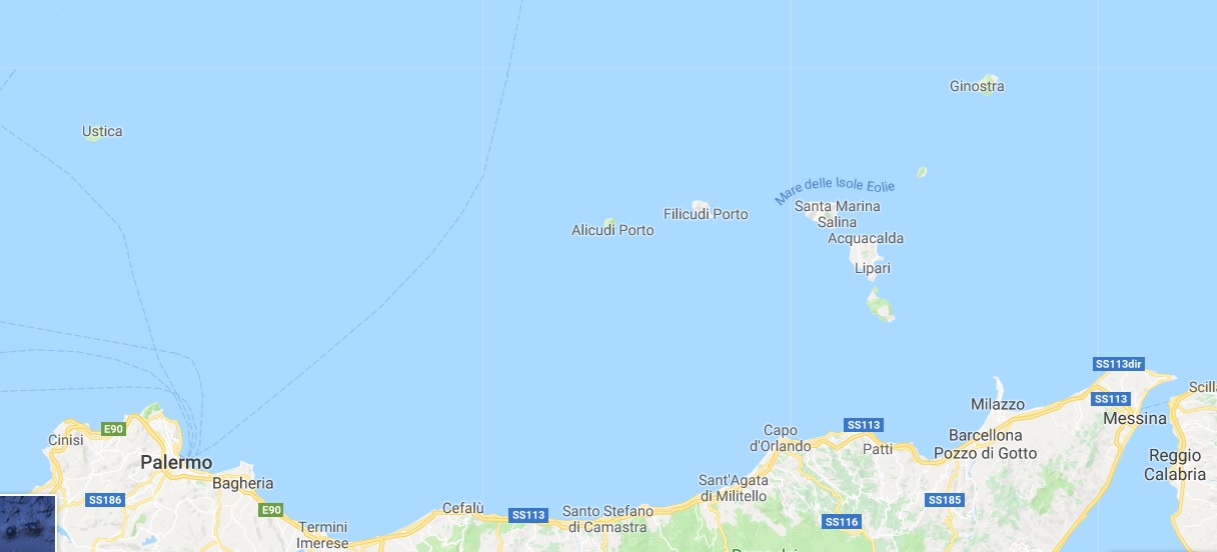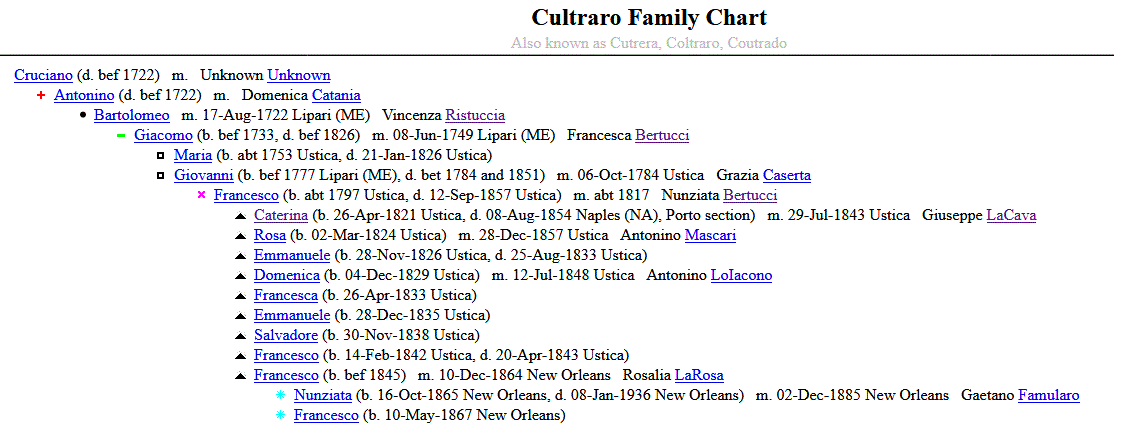
The Northern coast of Sicily with Ustica to left and Lipari to the right. |
The Lipari Church Registers from 1559-1913 are now viewable online! So what does this mean for us? Most of the original families that settled Ustica in the early 1760's came from Lipari. For those of us that are die-hard family researchers, that means we "SHOULD" be able to extend our families back two, three or more generations and tease out a little more of the migratory history of the Usticesi people. This is exciting stuff but a lot of work remains to make this a truly useful and user-friendly resource. The following is a synopsis of what I've found and done so far, and how you can begin using the Lipari Church Registers to add to the Ustica Genealogy Homepage (UGH) family charts.

The Northern coast of Sicily with Ustica to left and Lipari to the right. |
The Lipari church records are a new world for me. I have never researched records written in Latin and I was a little intimidated with the thought that there could be important clues in the text that would escape me. After scouring through hundreds of them, I am more confident but there are still many aspects of Latin (and habits of the priests recording the events) that elude and confuse me. As if reading ancient faded handwriting weren't difficult enough, abbreviations are used everywhere. There are also instances when the letter n or s is simply left off and some mark is made above the letter preceding the spot where the n or s would have been. So a surname like Bongiorno sometimes is written as Bōgiorno. Why they left the last n in place, I have no clue. Personal names in Latin also change with gender and number. A name like Giuseppe can occur as Josephus, Josepu, Josephum, Josephi, Josepho, Joseffus and simply Joseph. Given names often have a trailing tail which I often assumed to be a letter s. I also suspect that some Sicliano (the dialect of Sicicly - different from Italian) is creeping into the Latin. Names with double l, like Caravella, can be written as Caravedda. The surname Picone is often rendered as Picuni. The Latin letter x also shows up in surnames like Lixhiardo for Licciardo, t replaces z in names like Grazia/Gratia or Nunziata/Nuntiata, and f and ph are often interchanged. Some surnames have drastically changed for no apparent reason. The surname Basile is almost always written as Vasili. Bertucci is Birtuccio, Palmisano - Parmisano, Tranchina - Franchina or Branchina. I decided early on to be as faithful to the writting in the actual record as I could, though I draw the line at leaving out letters. Because this was a learning process for me, how I recorded names can be inconsistent.

The 1743 baptism of Cōcessa/Concessā Giuliano. Grandfathers are often listed. She was the daughter of Cono Giuliano (son of) the late Natalis and Catarina Pirera (daughter of) Salvatoris. Nic.s(Nicolaus) Ant.s(Antonius) Bōgiorno(Bongiorno) officated. Concessa is actually Concetta - another Latin oddity. |
There are actual indexes to the records within the registers but even those can be difficult to read and interpret, not to mention that many are apparently incomplete. I quickly decided that the best approach would be to manually index everything. That means reading every record and extracting out only the subject(s) and the image marker for the record so I could easliy revisit the record later. This was mainly driven by the difficulty I was having finding my Caravella ancestors, but the end result would benefit us all by providing a more reliable index that would give quick access to records of interest. At the writing of this article, I have marriages indexed from 1714-1800, baptisms from 1732-1745, deaths from 1774-1799. I am, of course, focusing on my direct ancestors and if you examine the What's New! section of the UGH, you'll see what I've added since May 2018. I'll only be entering records that deal with families that migrated to Ustica, so your task is to help me identify those documents. Look through the marriage index and if you find couples that are listed at the UGH, send me the index reference and I'll make sure to add the Lipari info to the UGH. You can always pull the images of the records yourself, if you are comfortable using the Mormon FamilySearh site. But ... before you get too excited we need to discuss the "GAP".
There is an important gap in the recorded history that most of us have not yet bridged. That gap is represented by the early church registers from Ustica. These exists only in the rectory of San Ferdinando Re parish in Ustica and it seems unlikely that they will ever be made available online. The only way to research them is to go there in person and request to view the registers. There is no precedence that I know of for doing this with the current pastor. In 1999, I was escorted by Vito Ailara to the rectory under the supervision of the then pastor, Alessandro Monzone. I did not handle the books. I simply told Vito what to look up and he read the information from the registers to me. I didn't even ask to take photos. I had written to Padre Alessandro previously requesting a few registers and after a few months he did respond and provide the information. This all seems rather anachronistic in light of today's fast-paced flood of information on the internet but some things just remain wedged in the past. In my fantasy world, the early registers would be methodically scanned, and later transposed to the family charts at the UGH. That could still happen but that would take a lot of negotiation and cooperation between our organization, the church, the Centro Studi and some other movers and shakers on the island. The parish does have a website which lists the church registers and counts of records.

From the UGH ... this Cultraro family was extended nearly 4 generations with the addition of just two Lipari marriage records. They migrated all over the map - Lipari, Ustica, Naples and New Orleans. |
Bridging that gap is important because the records for Ustica that are available at the UGH start in 1820. That leaves 60 years of records (1760-1820) that, for all practical purposes, are inaccessible, and will prevent most families from connecting over to the Liapri church records. The index of the Lipari Church Registers that is currently being built will be an invaluable tool for those families that are able to bridge the gap and for the chance that we one day arrive at my fantasy world. The index is posted at the Resource Page tab in the menu bar at the bottom of the UGH. More will be added as I work my way through the registers. Also there is an instructional video on using the FamilySearch site at the Help tab in the menu bar at the bottom of the UGH. Happy Hunting!